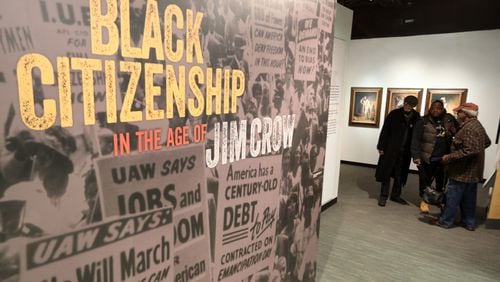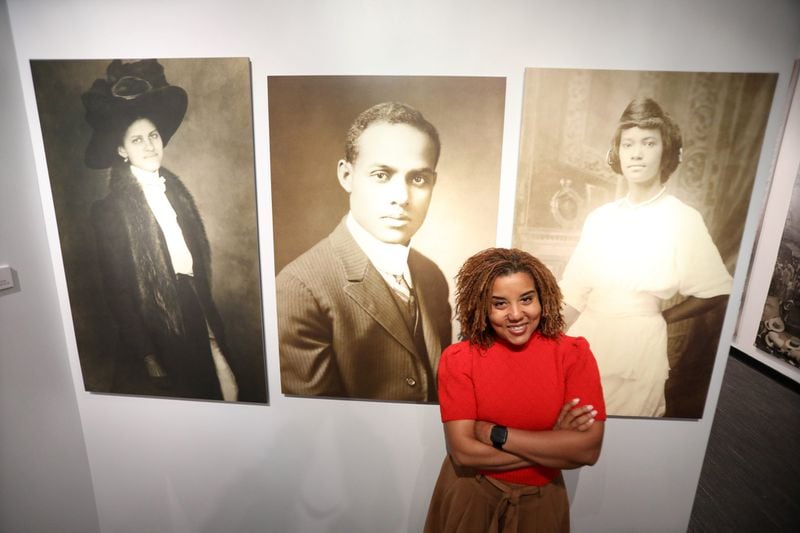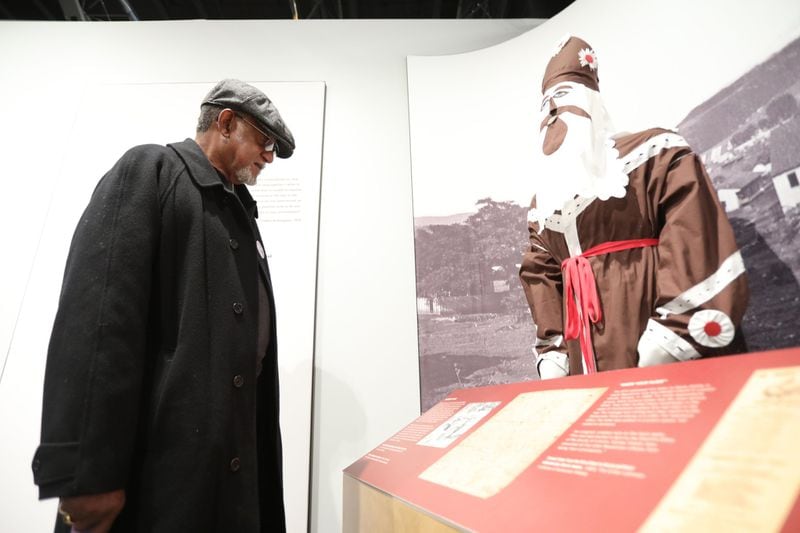The iron shackles that encircled the ankles of an enslaved black person are expected objects in the Atlanta History Center's new exhibition, "Black Citizenship in the Age of Jim Crow."
They are there, early in the show, encased in a Plexiglas box, thin yet sturdy reminders of the transatlantic slave trade that brought black people to these shores. This set is said to have bound a 17-year-old black girl. They are also bitter but essential artifacts in a show documenting the African American fight for full citizenship in a country where their ancestors arrived as captives.
But there is another important moment in the exhibition, a moment so fleeting a viewer might miss it. It’s in a 15-second video clip of the 1917 Negro Silent Protest parade. Close to 10,000 black people marched down Fifth Avenue in New York City to protest a rash of lynchings across the South. One man is marching with a huge sign that reads, “We Own 250,000 Farms, with 20,000,000 Acres of Land Worth, $500,000,000.” The message is historically correct. Back then, land ownership was one of the few and most powerful ways African Americans claimed their citizenship amid anti-black violence, voter suppression and segregation.
From the shackles to the march and beyond, the show documents the many ways African Americans fought for their constitutional right to be treated as full citizens: through voting, military service, education and land ownership. The show focuses on the period immediately after the Civil War, Reconstruction, up to World War I.
When talking about black history, “we tend to skip and go from the Civil War straight to civil rights,” said Calinda Lee, vice president at the history center. “It’s as if black Southerners were sitting down complacent while they waited for Martin Luther King to be born. And that’s not the case. We answer the question of why this period matters.”
The show was created in 2018 by the New York Historical Society in collaboration with the National Museum of African American History and Culture. Atlanta is the exhibition’s third stop on its national tour. It runs from now through June 30.
Because of Atlanta’s role as an incubator of African American progress, Lee, who is also lead curator of the show in Atlanta, expanded the show to incorporate that history. She collaborated with the Woodruff Library at the Atlanta University Center, the Spelman College Archives and the Clark Atlanta University Art Museum to include photographs, documents and artwork from their holdings. All are institutions that represent education’s role in the fight.
In one of those photos from the early 1900s, a group of 11 black women sits on the front steps of a home. They are all well-heeled, their legs all crossed at the ankles, a bygone show of ladylike modesty. At first glance, it would be easy to mistake the women for a social club. But they are members of the Neighborhood Union, started by Lugenia Burns Hope, who was first lady of Atlanta Baptist College, which would become Morehouse College.
The Neighborhood Union became one of the first social work organizations serving African American communities near the college. While it provided daycare, health care and social activities for families, it also served as a locus for community activism. It stepped into the breach created by legal segregation and served as one of Atlanta’s early social work organizations.
The bulk of the exhibition, however, explains why organizations like the Neighborhood Union were necessary: the broken promise of Reconstruction. Reconstruction began immediately after the Civil War when federal troops were sent South to keep order as the South rejoined the Union. Troops were to help emancipated black people live their new lives safely, which included the right to vote (for men only). Some troops ran Freedmen’s Bureau Schools. Progress began to take shape. Black men were elected to state legislatures. Had the troops remained in the South longer, African American’s tenuous hold on their new citizenship might have strengthened.
But troops were pulled out in 1877, and the violent campaign began to run blacks out of office, off their newly purchased land and deny them their new constitutional rights.
A chilling reminder of how that reign of terror was enforced stands in the Nicholson Gallery. It’s a colorful costume, a brown robe accented by a tall brown cap with a white mask attached the front. The front of the mask is appliqué with black eyes, nose, beard and mustache. Red flower patches and a matching belt complete the costume. This is the replica of an early Ku Klux Klan uniform from Tennessee. A sign next to it says it’s based on an original that was likely sewn by family members of the robe’s owner.
From state to state, the North and South, anti-black laws were passed to legally augment the violence. Also on display in the gallery is a facsimile of “Lynch Law in Georgia,” by pioneering journalist Ida B. Wells-Barnett. Now an icon to many black women, she was an African American who devoted her career to documenting and campaigning against racially motivated murders of black people. The subtitle of her pamphlet reads: “A Six-Weeks’ Record in the Center of Southern Civilization as Faithfully Chronicled by the ‘Atlanta Journal’ and the ‘Atlanta Constitution.’” Newspapers often covered lynchings, and the tone of the stories was usually supportive of the lynch mob.
But Wells-Barnett’s document represents not a glorification of black trauma, but is an example of black agency, Lee said. For as difficult as some of the moments are in the show, they explain the difficult fight for equal rights that in some ways is still being battled today.
“This is not an easy story to tell,” Lee said. “But this is about our shared history.”
VISUAL ARTS PREVIEW
“Black Citizenship in the Age of Jim Crow”
10 a.m.-5:30 p.m. Monday-Saturday; noon-5:30 p.m. Sunday. $9-$21.50.
Atlanta History Center, 130 W. Paces Ferry Road NW, Atlanta. 404-814-4000, atlantahistorycenter.com.
About the Author









